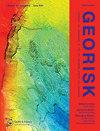Traditional Nomadism Offers Adaptive Capacity to Northern Mongolian Geohazards
IF 4.8
3区 工程技术
Q1 ENGINEERING, GEOLOGICAL
Georisk-Assessment and Management of Risk for Engineered Systems and Geohazards
Pub Date : 2023-08-11
DOI:10.3390/geohazards4030019
引用次数: 0
Abstract
Mongolia’s northernmost province, Khövsgöl Aimag, famous for its massive Lake Khövsgöl set among the mountainous steppe, taiga, and tundra forests, increasingly attracts both domestic and international tourists. Before the COVID-19 pandemic, Mongolia received over 500,000 tourists annually. The aimag is also home to Indigenous, nomadic Dukha reindeer herders and semi-nomadic Darkhad cattle herders. Using a multidisciplinary approach, this study uses an analytical hierarchy process to map areas in Khövsgöl Aimag, where the infrastructure, including buildings, dwellings, formal and informal roads, and pastureland, is subject to geohazards. The hazards of interest to this mapping analysis include mass wasting, flooding, and permafrost thawing, which threaten roads, pastures, houses, and other community infrastructure in Khövsgöl Aimag. Based on the integrated infrastructure risk map, an estimated 23% of the aimag is at high to very high risk for localized geohazards. After a discussion of the results informed by the interviews, mobile ethnographies, and local and national land use policies, we postulate that communities exercising more traditional nomadic lifestyles with higher mobility are more resilient to these primarily localized geohazards.传统游牧对蒙古北部地质灾害的适应能力
蒙古最北部的省份,Khövsgöl艾马格,以其巨大的湖Khövsgöl而闻名,该湖位于山区草原,针叶林和苔原森林之间,越来越多地吸引着国内外游客。新冠肺炎疫情前,蒙古每年接待游客超过50万人次。aimag也是土著、游牧的Dukha驯鹿牧民和半游牧的Darkhad牛牧民的家园。本研究采用多学科方法,采用层次分析法绘制了Khövsgöl Aimag的基础设施(包括建筑物、住宅、正式和非正式道路以及牧场)易受地质灾害影响的区域。地图分析中涉及的危害包括大规模的浪费、洪水和永久冻土融化,这些威胁到Khövsgöl Aimag的道路、牧场、房屋和其他社区基础设施。根据综合基础设施风险图,估计23%的目标处于局部地质灾害的高至极高风险。在对访谈、流动民族志以及地方和国家土地使用政策的结果进行讨论后,我们假设,采用更传统的游牧生活方式、流动性更高的社区对这些主要是局部地质灾害的抵御能力更强。
本文章由计算机程序翻译,如有差异,请以英文原文为准。
求助全文
约1分钟内获得全文
求助全文
来源期刊
CiteScore
8.70
自引率
10.40%
发文量
31
期刊介绍:
Georisk covers many diversified but interlinked areas of active research and practice, such as geohazards (earthquakes, landslides, avalanches, rockfalls, tsunamis, etc.), safety of engineered systems (dams, buildings, offshore structures, lifelines, etc.), environmental risk, seismic risk, reliability-based design and code calibration, geostatistics, decision analyses, structural reliability, maintenance and life cycle performance, risk and vulnerability, hazard mapping, loss assessment (economic, social, environmental, etc.), GIS databases, remote sensing, and many other related disciplines. The underlying theme is that uncertainties associated with geomaterials (soils, rocks), geologic processes, and possible subsequent treatments, are usually large and complex and these uncertainties play an indispensable role in the risk assessment and management of engineered and natural systems. Significant theoretical and practical challenges remain on quantifying these uncertainties and developing defensible risk management methodologies that are acceptable to decision makers and stakeholders. Many opportunities to leverage on the rapid advancement in Bayesian analysis, machine learning, artificial intelligence, and other data-driven methods also exist, which can greatly enhance our decision-making abilities. The basic goal of this international peer-reviewed journal is to provide a multi-disciplinary scientific forum for cross fertilization of ideas between interested parties working on various aspects of georisk to advance the state-of-the-art and the state-of-the-practice.

 求助内容:
求助内容: 应助结果提醒方式:
应助结果提醒方式:


